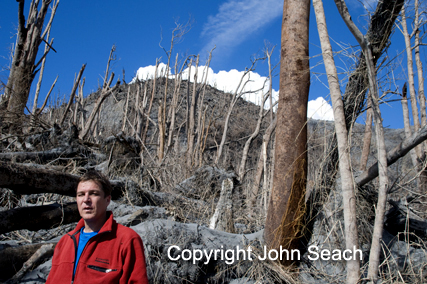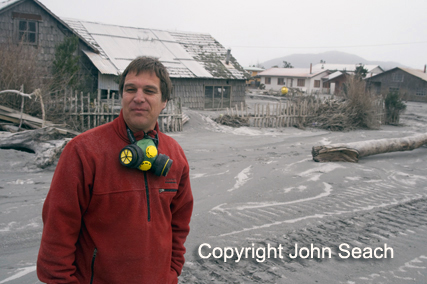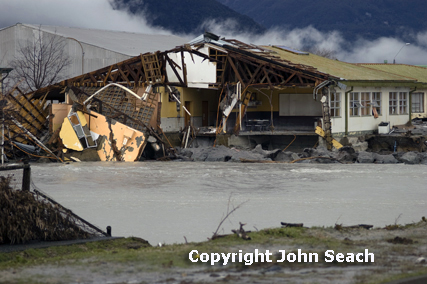John Seach was the first scientist to climb to the summit of Chaiten volcano after the May 2008 eruption.
John made two expeditions to Chaiten volcano in 2008
Chaitén volcano is located in southern Chile, 10 km NE of the town of Chaitén on the Gulf of Corcovado. The volcano contains an obsidian lava dome in a 3.5 km wide caldera. The volcano is occasionally covered with snow, but does not contain a glacier. Two small lakes occupy the caldera floor on the west and north sides of the lava dome.

John Seach climbing to the summit of Chaiten volcano August 2008.
Warning - Climbing Chaiten volcano is currently dangerous and should not be attempted.

John Seach at Chaitén town in July 2008

School damaged by lahars in Chaiten town - John Seach
John Seach at Chaiten volcano, 2008.
The volcano erupted on 2nd May 2008. Ash emissions reached a height of 30 km (100,000 ft) on 6th May. More than 4000 people were evacuated fromnearby villages and the town of Chaiten, 10 km from the volcano, and Futaleufu 70 km southeast. This was the first historical eruption at the volcano. The previous dated eruption was over 9000 years ago. The eruption was possibly triggered by tectonic shifts that opened tear faults and promote magma to rise to the surface.
During a visit to Chaitén volcano in Chile on 9th July, John Seach observed lahar destruction of the town, and ashfall damage to surrounding areas, and pyroclastic flow devastation on the north flank of the volcano. On the north side of the volcano at a location 3 km from the crater, an area of devastated forest was visited. Plinian eruptions, and pyroclastic flows, burnt forest and stripped trees of foliage. An area of 10 sq km on the north side of the crater was completely devoid of vegetation, except for some standing devastated trees. Trees up to a meter in diameter were snapped off at a height of 4 m. Fire had burnt the entire area. The field area consisted of a mixture of standing devastated trees, fallen trees, and deep ash deposits. A sharp distinction was observed between areas of devastated forest and standing untouched forest. Continuous ash fall occurred in Chaitén town. Lahars were reaching the town once per week. Residents were allowed into the town to evacuate possessions and begin the clean up. Residents reported hearing rumbling noises under the town, similar to the sound of running water.
In August 2008 John Seach was the first scientist to climb to summit of Chaiten volcano after the May eruption. The summit crater contained a 120 m high lava dome. Earthquakes were felt at the summit. The lava dome was loudly degassing, and lava boulders avalanched from the dome side to the crater floor. John Seach was the first scientist to climb to summit of Chaiten volcano after the worlds largest rhyolite eruption in 100 years.
Taken from www.volcanolive.com

clouds seen concentrating on the south west bay.. May be signs of low pressure forming.But the COLA weather model says this system will move northeast to head towards Myanmar and Thailand.. Storms in April usually head towards the Arakan Coast. But by chance if it hits the TN coast, we will be having some relief from the sweltering heat.
ReplyDeleteHope this system gives rain to Tamilnadu.....
情色電影, aio交友愛情館, 言情小說, 愛情小說, 色情A片, 情色論壇, 色情影片, 視訊聊天室, 免費視訊聊天, 免費視訊, 視訊美女, 視訊交友, ut聊天室, 視訊聊天, 免費視訊聊天室, a片下載, av片, A漫, av dvd, av成人網, 聊天室, 成人論壇, 本土自拍, 自拍, A片,
ReplyDelete愛情公寓, 情色, 舊情人, 情色貼圖, 情色文學, 情色交友, 色情聊天室, 色情小說, 一葉情貼圖片區, 情色小說, 色情, 色情遊戲, 情色視訊, 情色電影, aio交友愛情館, 色情a片, 一夜情, 辣妹視訊, 視訊聊天室, 免費視訊聊天, 免費視訊, 視訊, 視訊美女, 美女視訊, 視訊交友, 視訊聊天, 免費視訊聊天室, 情人視訊網, 影音視訊聊天室, 視訊交友90739, 成人影片, 成人交友,
免費A片, 本土自拍, AV女優, 美女視訊, 情色交友, 免費AV, 色情網站, 辣妹視訊, 美女交友, 色情影片, 成人影片, 成人網站, A片,H漫, 18成人, 成人圖片, 成人漫畫, 情色網,